Applying Cognitive Linguistics to Teaching English Prepositions: A QuasiExperimental Study
This quasi-experimental study aimed to investigate the effectiveness of applying
cognitive linguistics (CL) to teaching English prepositions. The pretest-posttest
between-group design was adopted. The participants were selected according to
their previous learning experiences, regular out-of-class exposure, eagerness for
joining the study, and pretest results. The spatial and metaphorical meanings of the
prepositions above, among, at, behind, beside, between, in, in front of, on and
under were taught in 4 sessions of 90 minutes. The Cognitive Group received CLbased instructions and the Traditional Group received instructions based on vivid
pictures and verbal explanations. The findings showed that the Cognitive Group
outperformed the Traditional Group in the posttest in terms of both the spatial and
metaphorical meanings. It can be said that CL-based instruction can help learners
improve their knowledge of the prepositions better than the traditional pedagogical
application. It is recommended that applying cognitive linguistics can help students
of other languages master English prepositions. The participants’ responses to the
questionnaires also assured research reliability and validity.
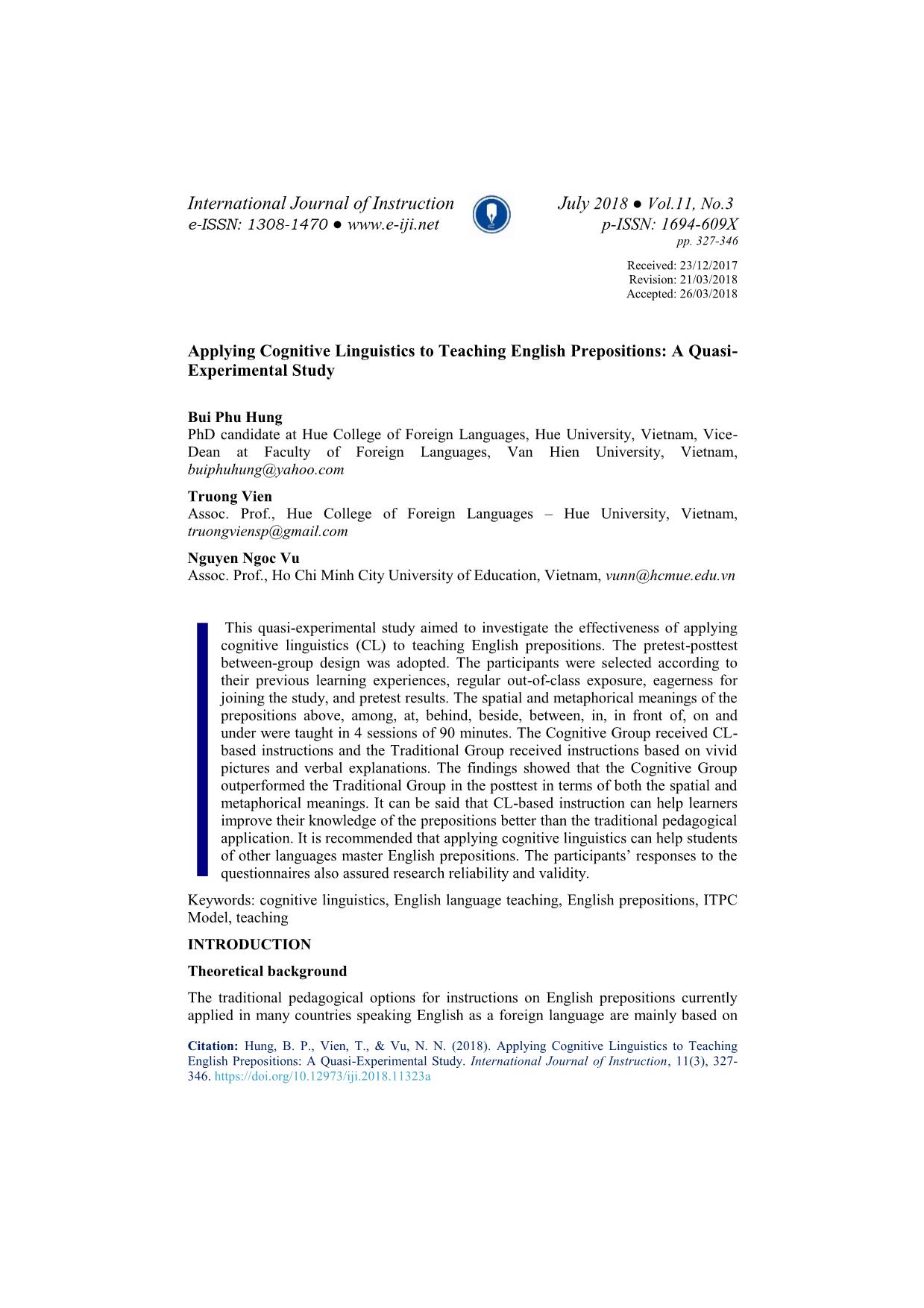
Trang 1
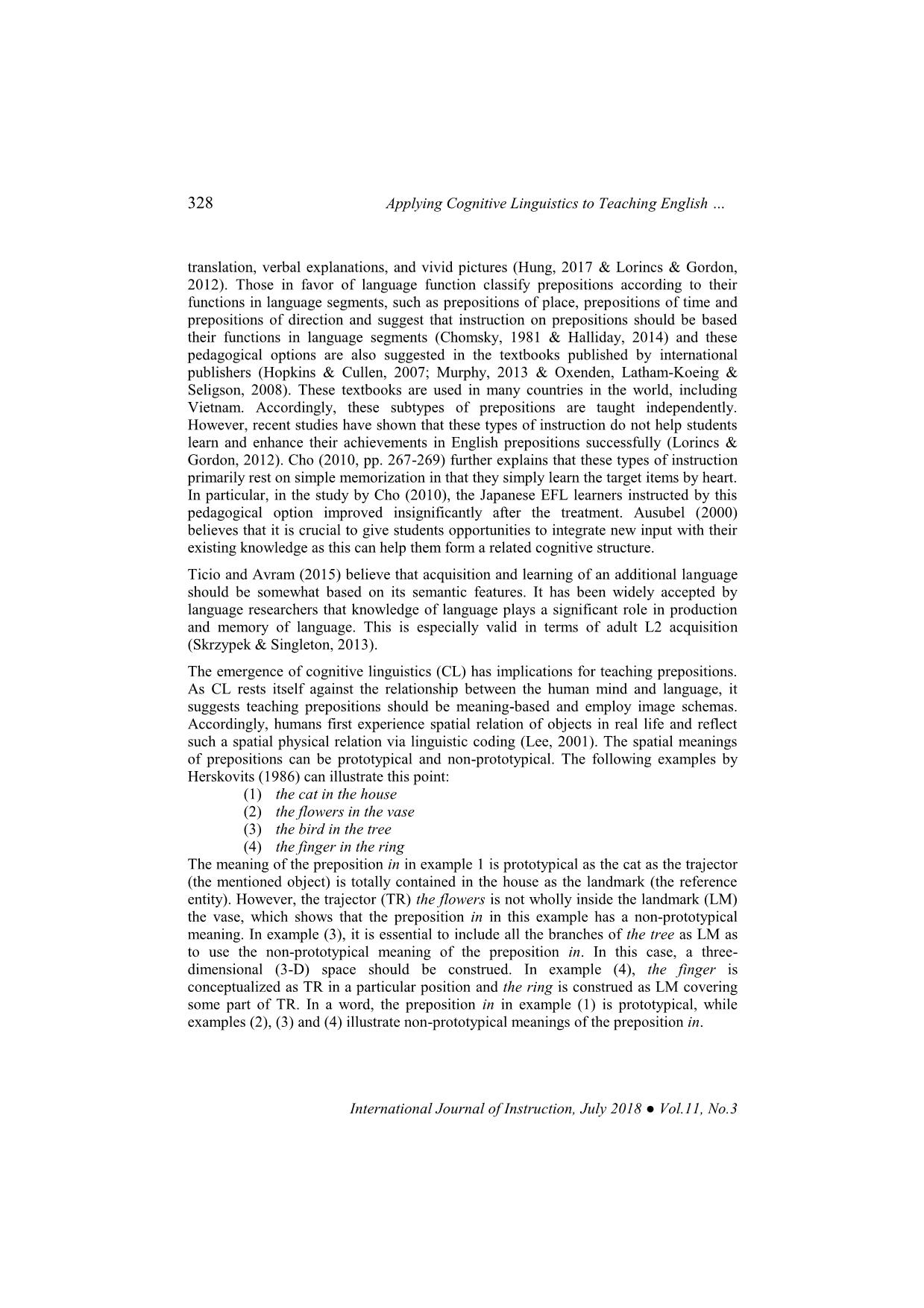
Trang 2
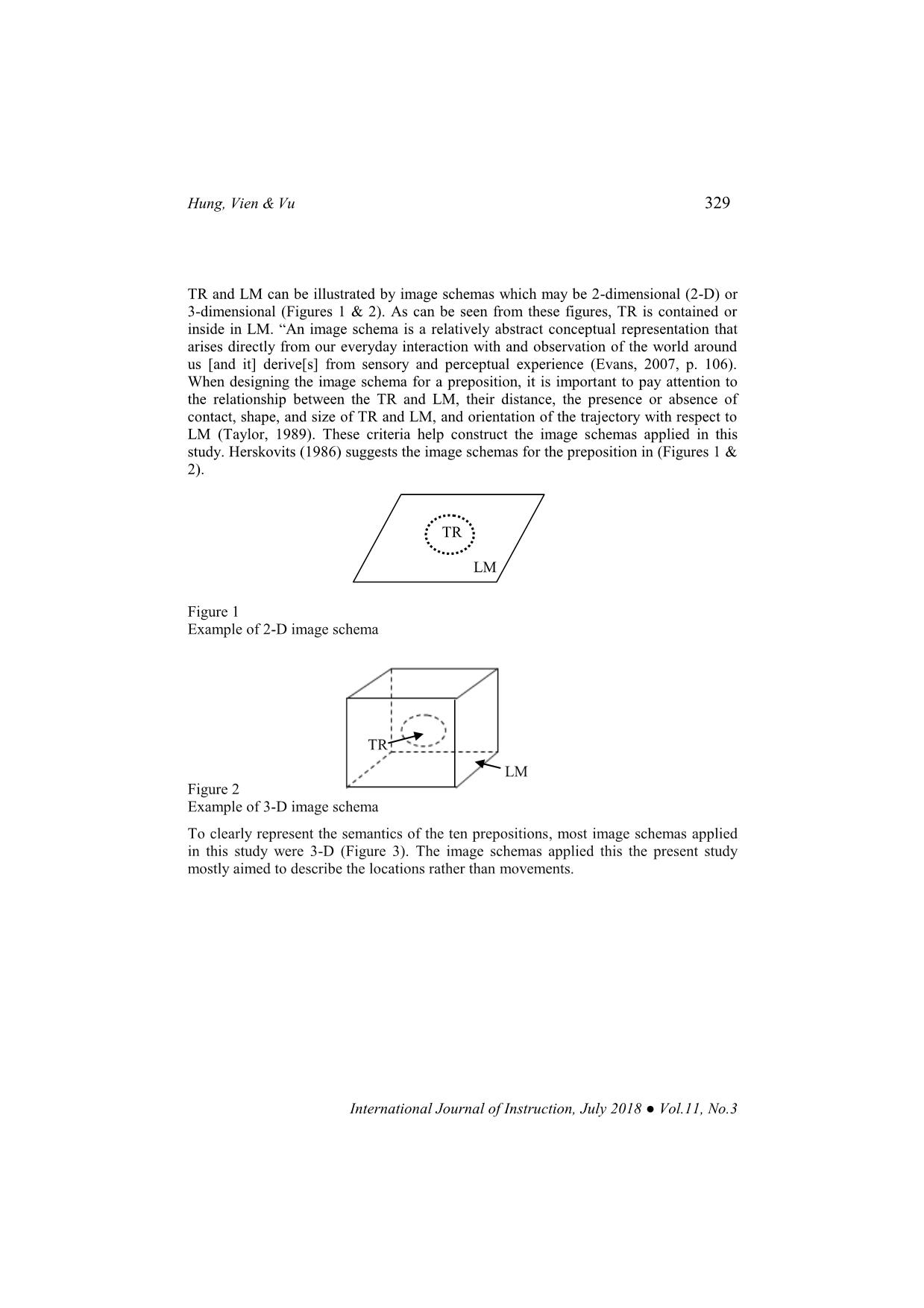
Trang 3
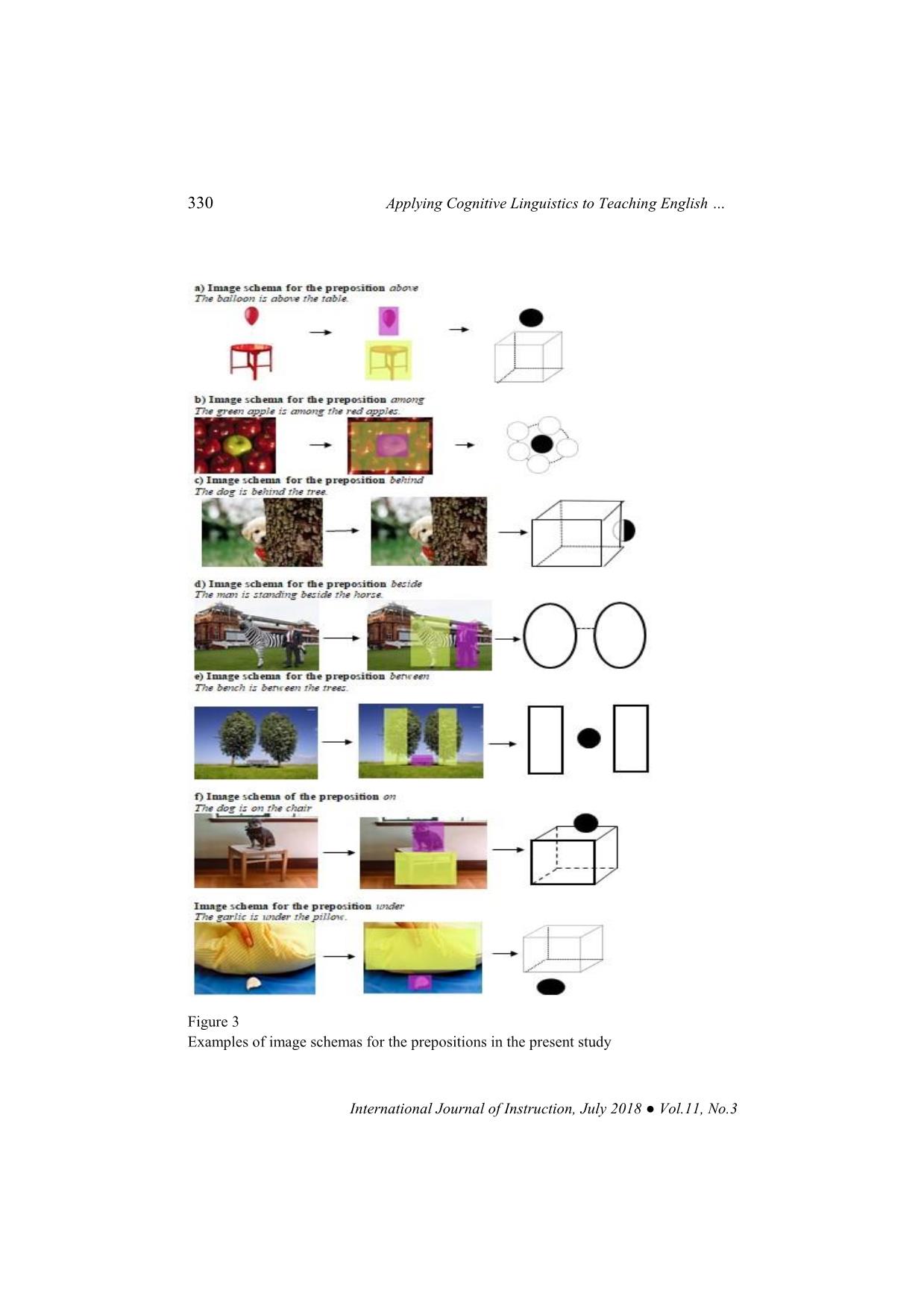
Trang 4
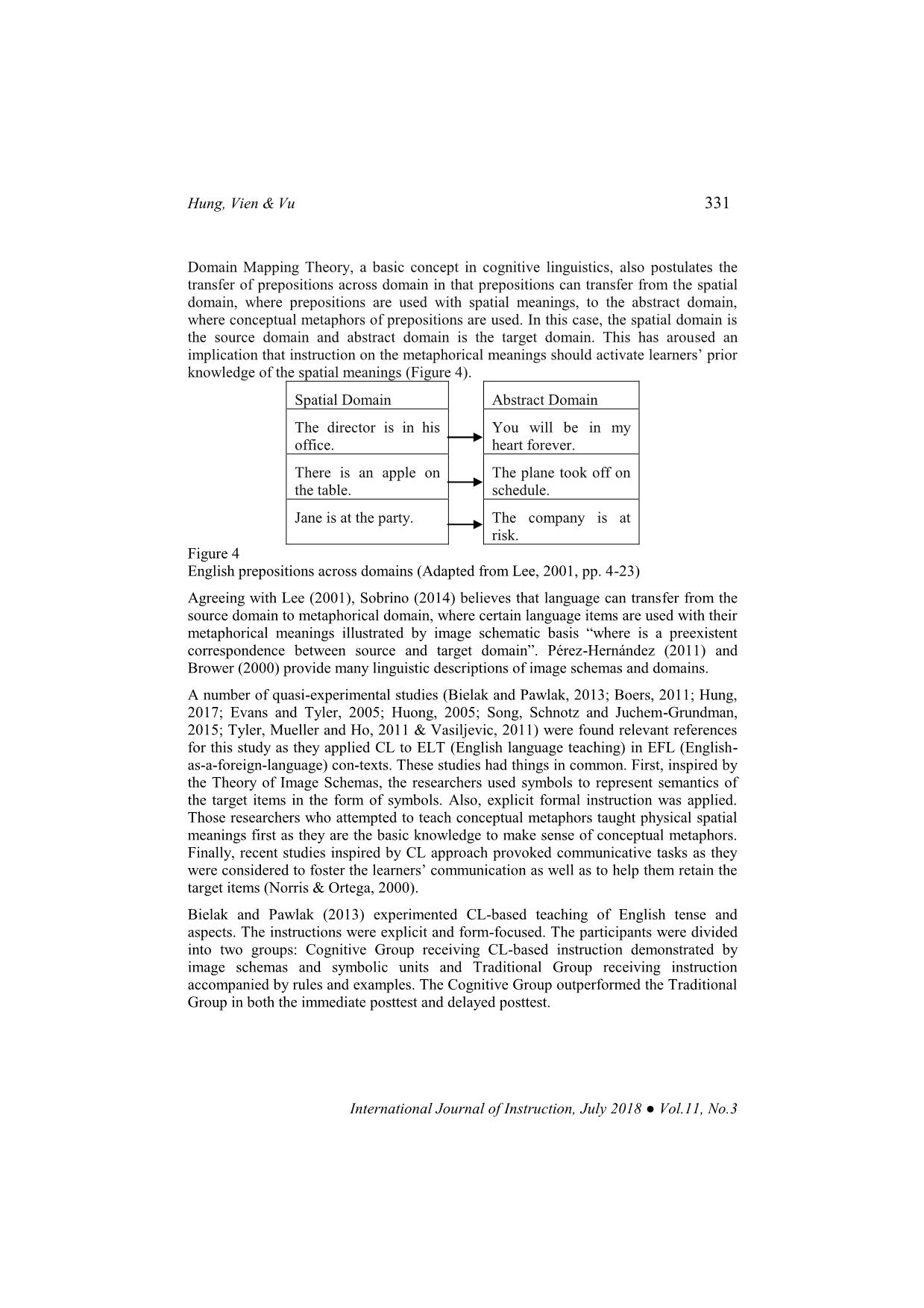
Trang 5

Trang 6

Trang 7
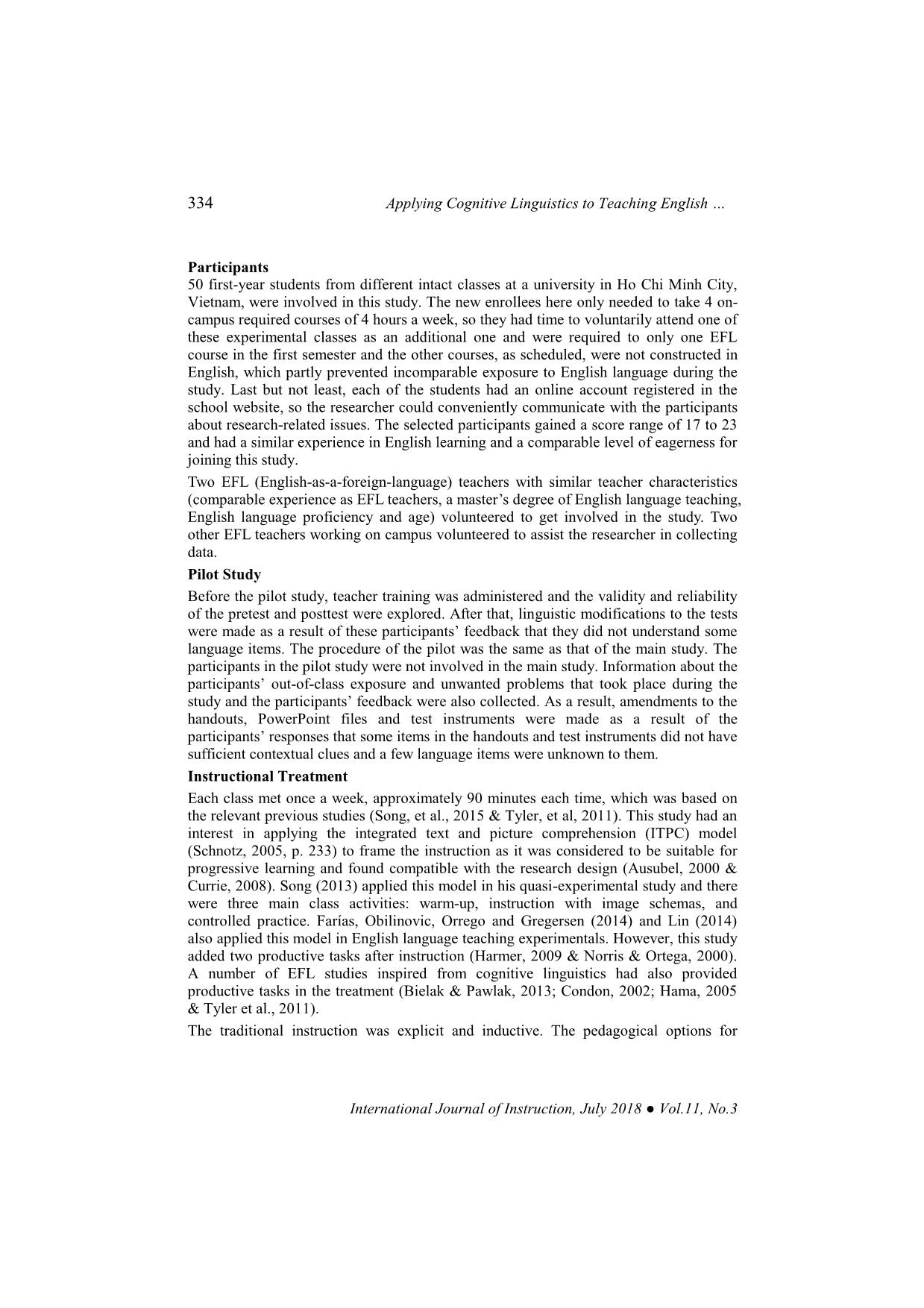
Trang 8
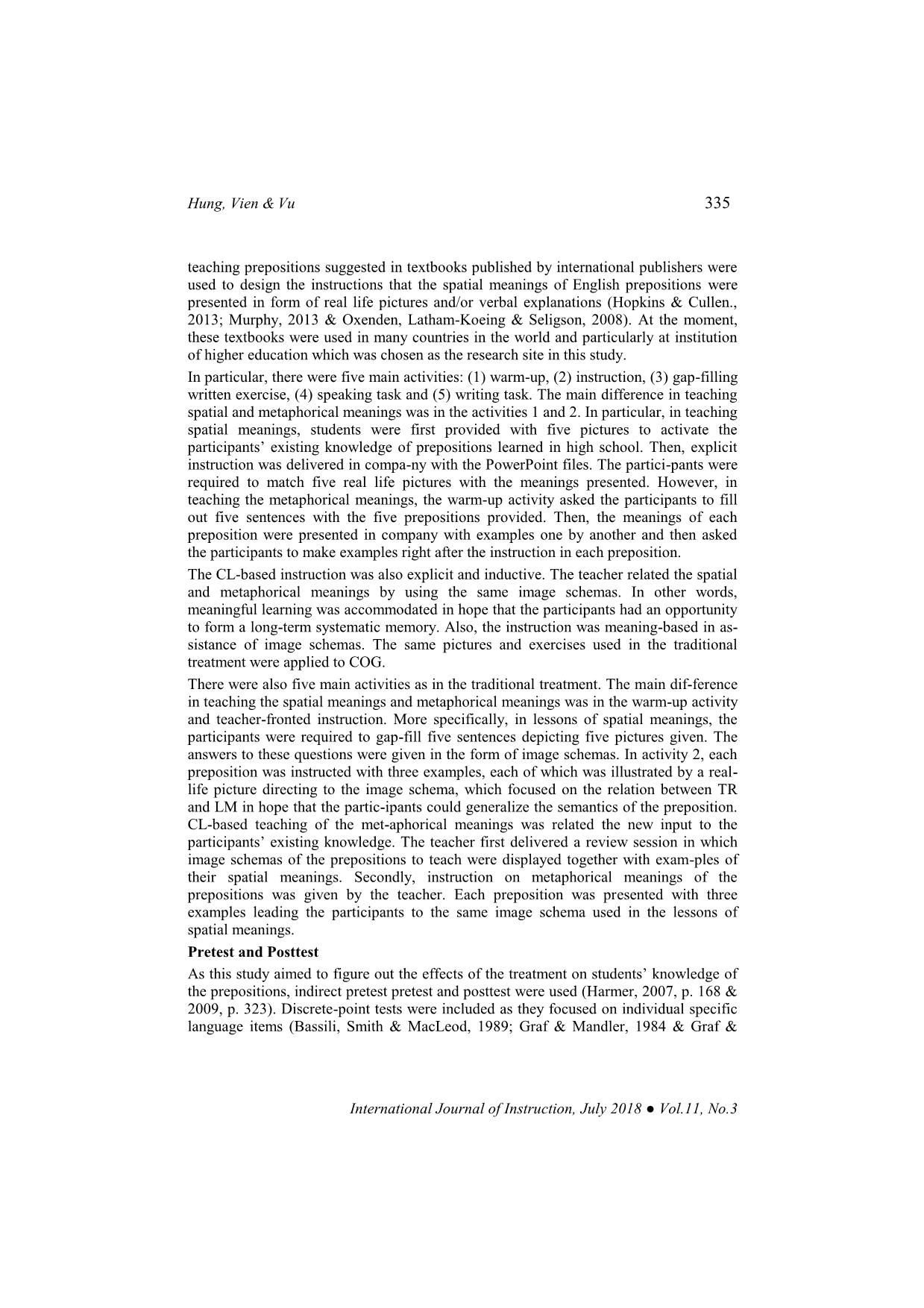
Trang 9
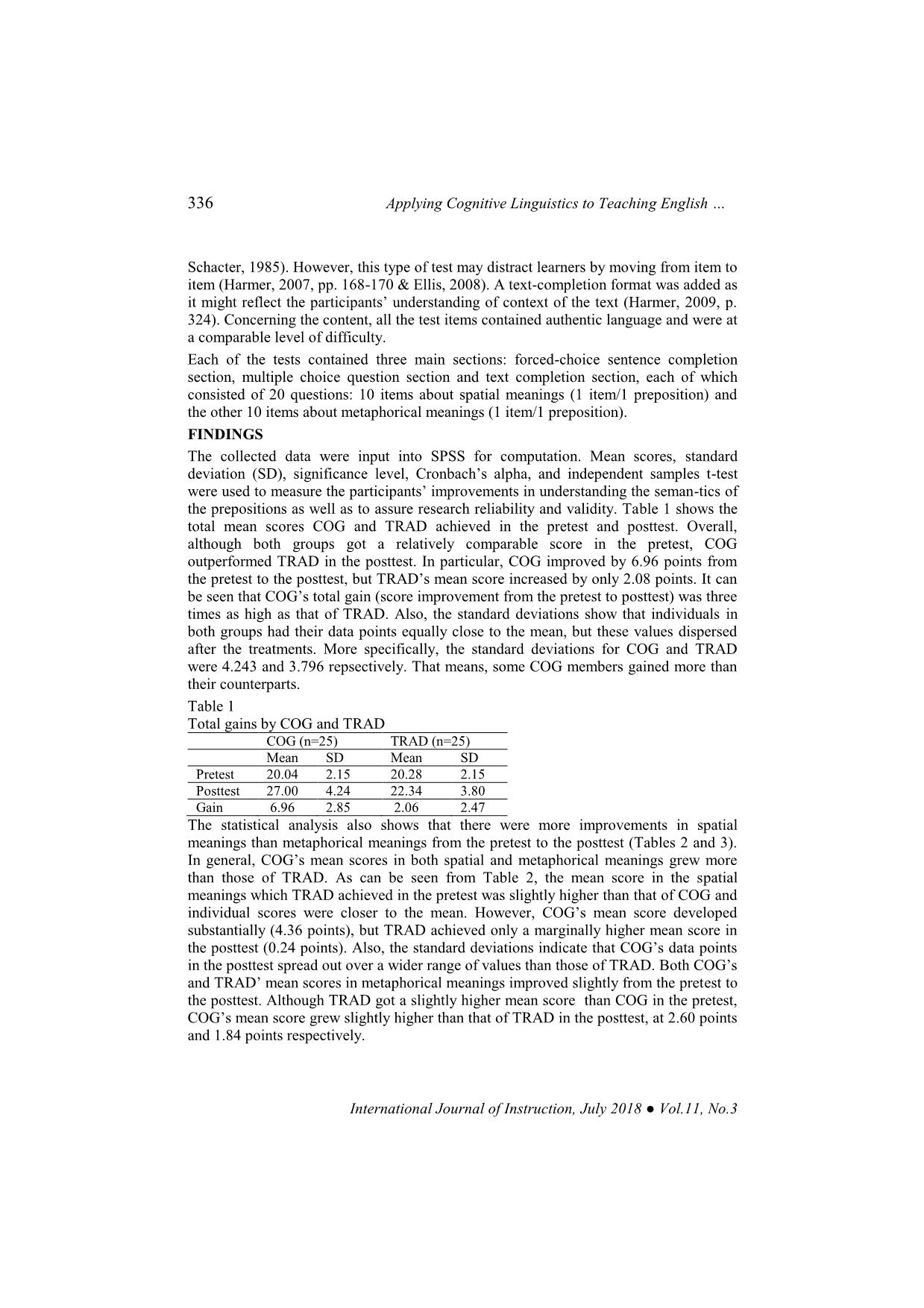
Trang 10
Tải về để xem bản đầy đủ
Tóm tắt nội dung tài liệu: Applying Cognitive Linguistics to Teaching English Prepositions: A QuasiExperimental Study
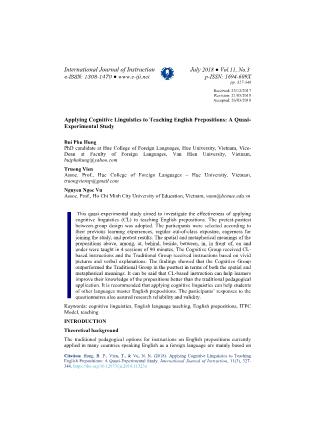
International Journal of Instruction July 2018 ● Vol.11, No.3 e-ISSN: 1308-1470 ● www.e-iji.net p-ISSN: 1694-609X pp. 327-346 Citation: Hung, B. P., Vien, T., & Vu, N. N. (2018). Applying Cognitive Linguistics to Teaching English Prepositions: A Quasi-Experimental Study. International Journal of Instruction, 11(3), 327- 346. https://doi.org/10.12973/iji.2018.11323a Received: 23/12/2017 Revision: 21/03/2018 Accepted: 26/03/2018 Applying Cognitive Linguistics to Teaching English Prepositions: A Quasi- Experimental Study Bui Phu Hung PhD candidate at Hue College of Foreign Languages, Hue University, Vietnam, Vice- Dean at Faculty of Foreign Languages, Van Hien University, Vietnam, buiphuhung@yahoo.com Truong Vien Assoc. Prof., Hue College of Foreign Languages – Hue University, Vietnam, truongviensp@gmail.com Nguyen Ngoc Vu Assoc. Prof., Ho Chi Minh City University of Education, Vietnam, vunn@hcmue.edu.vn This quasi-experimental study aimed to investigate the effectiveness of applying cognitive linguistics (CL) to teaching English prepositions. The pretest-posttest between-group design was adopted. The participants were selected according to their previous learning experiences, regular out-of-class exposure, eagerness for joining the study, and pretest results. The spatial and metaphorical meanings of the prepositions above, among, at, behind, beside, between, in, in front of, on and under were taught in 4 sessions of 90 minutes. The Cognitive Group received CL- based instructions and the Traditional Group received instructions based on vivid pictures and verbal explanations. The findings showed that the Cognitive Group outperformed the Traditional Group in the posttest in terms of both the spatial and metaphorical meanings. It can be said that CL-based instruction can help learners improve their knowledge of the prepositions better than the traditional pedagogical application. It is recommended that applying cognitive linguistics can help students of other languages master English prepositions. The participants’ responses to the questionnaires also assured research reliability and validity. Keywords: cognitive linguistics, English language teaching, English prepositions, ITPC Model, teaching INTRODUCTION Theoretical background The traditional pedagogical options for instructions on English prepositions currently applied in many countries speaking English as a foreign language are mainly based on 328 Applying Cognitive Linguistics to Teaching English International Journal of Instruction, July 2018 ● Vol.11, No.3 translation, verbal explanations, and vivid pictures (Hung, 2017 & Lorincs & Gordon, 2012). Those in favor of language function classify prepositions according to their functions in language segments, such as prepositions of place, prepositions of time and prepositions of direction and suggest that instruction on prepositions should be based their functions in language segments (Chomsky, 1981 & Halliday, 2014) and these pedagogical options are also suggested in the textbooks published by international publishers (Hopkins & Cullen, 2007; Murphy, 2013 & Oxenden, Latham-Koeing & Seligson, 2008). These textbooks are used in many countries in the world, including Vietnam. Accordingly, these subtypes of prepositions are taught independently. However, recent studies have shown that these types of instruction do not help students learn and enhance their achievements in English prepositions successfully (Lorincs & Gordon, 2012). Cho (2010, pp. 267-269) further explains that these types of instruction primarily rest on simple memorization in that they simply learn the target items by heart. In particular, in the study by Cho (2010), the Japanese EFL learners instructed by this pedagogical option improved insignificantly after the treatment. Ausubel (2000) believes that it is crucial to give students opportunities to integrate new input with their existing knowledge as this can help them form a related cognitive structure. Ticio and Avram (2015) believe that acquisition and learning of an additional language should be somewhat based on its semantic features. It has been widely accepted by language researchers that knowledge of language plays a significant role in production and memory of language. This is especially valid in terms of adult L2 acquisition (Skrzypek & Singleton, 2013). The emergence of cognitive linguistics (CL) has implications for teaching prepositions. As CL rests itself against the relationship between the human mind and language, it suggests teaching prepositions should be meaning-based and employ image schemas. Accordingly, humans first experience spatial relation of objects in real life and reflect such a spatial physical relation via linguistic coding (Lee, 2001). The spatial meanings of prepositions can be prototypical and non-prototypical. The following examples by Herskovits (1986) can illustrate this point: (1) the cat in the house (2) the flowers in the vase (3) the bird in the tree (4) the finger in the ring The meaning of the preposition in in example 1 is prototypical as the cat as the trajector (the mentioned object) is totally contained in the house as the landmark (the reference entity). However, the trajector (TR) the flowers is not wholly inside the landmark (LM) the vase, which shows that the preposition in in this example has a non-prototypical meaning. In example (3), it is essential to include all the branches of the tree as LM as to use the non-prototypical meaning of the preposition in. In this case, a three- dimensional (3-D) space should be construed. In example (4), the finger is conceptualized as TR in a particular position and the ring is construed as LM covering some part of TR. In a word, the preposition in in example (1) is prototypical, while examples (2), (3) and (4) illustrate n ... ut there was only a minor dif-ference in the improvements of their knowledge of the metaphorical meanings. However, the study by Song, et al. (2015) admitted that COG and TRAD improved less than the two 342 Applying Cognitive Linguistics to Teaching English International Journal of Instruction, July 2018 ● Vol.11, No.3 groups involved in this present study. In the former study, the scores achieved by COG and TRAD totally rose by 3.32 points and 0.81 points respectively. COG’s score for the spatial meanings and metaphorical meanings developed by 1.01 points and 1.74 points respectively, but TRAD lost 0.04 point for the spatial meanings and gained 1.18 point for the metaphorical meanings. An explanation for this difference may have been in the pedagogical applications in that there was no evidence that the former study applied these post-teaching activities. Lee (2003), Nagy and Scott (2000), Schmitt (2008) and Shintani (2011) assert that these post-teaching activities could contribute to learners’ retention of the target items. Also, this study generally confirmed the study by Tyler, et al. (2011). In the previous study by Tyler et al. (2011), COG gained 4.9 points on average. Only one participant lost one point and the other participants generally made significant gains. However, the data analysis, as admit-ted by the researchers, was relatively simple. There were no discussions on gains in different semantic facets of the prepositions. It was hard to make further comparisons between the findings from these two studies. CONCLUSION The present study aimed to investigate the effectiveness of applying CL-based ap-proach to teaching both spatial and meta-phorical meanings of prepositions. The study also compared the findings from the CL-based instructional description and tra-ditional instructional description. The findings from this study were in line with local and international studies of applying this approach (Hung, 2017; Huong, 2005; Song et al., 2015 & Tyler et al. 2011). CL-based approach provided L2 learners with signifi-cant understandings of the spatial and met-aphorical meanings of prepositions. After CL- based instructions of totally 6 hours, the participants showed considerable gains, with the assistance of visual aids mainly from the PowerPoint files. The participants’ responses to the questionnaire illustrated that COG and TRAD generally had comparable out-of-class exposure during the study. More specifically, one of them remained free from extra courses in English. They did not watch movies in English nor converse with for-eigners in English as they believed they were not proficient enough for that. Three participants from COG and five participants from TRAD watched American films dubbed into Vietnamese, and they did not pay attention to English subtitles at all. They did not join any website written in English during the study. All of them also revealed that each participant reviewed the lesson from 20 to 30 minutes each week. The statistical analysis shows that the study gave more positive findings than the previous studies (Song et al., 2015). This may have been caused by the participants’ additional practices of productive skills after instruction. In addition, the use of image schemas in instructing spatial and metaphor-ical meanings of prepositions was valid. The prepositions had opportunities to transfer from the spatial domain to the abstract do- main via the use of image schemas. However, the research population was quite limited. Also, the exploration into sub-ject interferences with the findings were based on the learners’ responses. Finally, cognitive Hung, Vien & Vu 343 International Journal of Instruction, July 2018 ● Vol.11, No.3 linguistics was a usage-based ap-proach (Evans & Green, 2006). In other words, language fluency was not a focus of the treatment. Although the participants were involved in productive tasks, the teacher-fronted time was the main input. This was also reflected in the measures of the pretest and posttest, which was in the form of direct tests. These participants were first-year students who already learned prepositions in traditional approach in high school and the pretest and posttest contained simple vocab- ulary and clues for them to choose the right answers. The application should be extended in different contexts to know to what extent this approach is valid. This article provides an insight into the effectiveness of applying cognitive linguistic approach to Eng-lish language teaching and its pedagogical applications give implications for practices and studies (Langacker, 2008, p.66). There should be more experimental studies apply-ing cognitive linguistics to ELT. The unex-plored areas of the application of cognitive linguistics can be endeavors to ELT researchers and practitioners. Future studies applying cognitive linguistics in different contexts can provide better insights into its range of applications in ELT. REFERENCES Ausubel, D. P. (2000). The acquisition and retention of knowledge: a cognitive view. Boston: Kluwer Academic Publishers. Bassili, J. N., Smith, M. C. & MacLeod, C. M. (1989). Auditory and visual word-stem completion: separating data driven and conceptuallly driven processing. The Quaterly Journal of Experimental Psychology, 41A (3), 439-453. https://doi.org/10.1080/14640748908402375 Bielak, J. & Pawlak, M. (2013). Applying cognitive grammar in the foreign language classroom: Teaching English tense and aspect. Kalisz, Poland: Springer. Boers, F. (2011). Cognitive semantic ways of teaching figurative phrases: an assessment. Review of Cognitive Linguistics 9(1), 227-261. https://doi.org/10.1075/rcl.9.1.11be Brower, C. (2000). A cognitive theory of musical meaning. Journal of Music Theory 44 (2), 323-379. https://doi.org/ 10.2307/3090681. Cho, K. (2010). Fostering the acquisition of English prepositions by Japanese learners with networks and prototypes. In S. D. Knop, F. Boers & A. D. Rycker (Eds.), Fostering language teaching efficiency through cognitive linguistics (pp. 259-275). Berlin: Mouton de Gruyter. Condon, N. (2002). A cognitive approach to phrasal verbs: How useful is it?”. IVACS Conference: University of Limerick, Ireland. Currie, Q. T. (2008). Animation as reality: factors impacting cognitive load in studio- based E-learning. Unpublished Doctoral dissertation, Capella University. Retrieved 344 Applying Cognitive Linguistics to Teaching English International Journal of Instruction, July 2018 ● Vol.11, No.3 from https://search.proquest.com/openview/d7ef7a6c9139610f8c36d7a0bf1b1909/1?pq- origsite=gscholar&cbl=18750&diss=y Ellis, R. (2008). Investigating grammatical difficulty in second language learning: Implications for second language acquisition research and language testing”. International Journal of Applied Linguistics, 18, 4-22. https://doi.org/ 10.1111/j.1473- 4192.2008.00184.x. Evans, V. (2007). A glossary of cognitive linguistics. Utah: University of Utah Press. Evans, V. & Green, M. (2006). Cognitive linguistics. An introduction. Edinburgh: Edinburgh University Press. Evans, V. & Tyler, A. (2005). Applying cognitive linguistics to pedagogical grammar: the English prepositions of verticality. Revista Brasileira de Linguística Aplicada, 5(2), 11-42. 2005000200002 Farías, M., Obilinovic, K., Orrego, R. & Gregersen, T. 2014. Evaluating types and combinations of multimodal presentations in the retention and trasnfer of concrete vocabulary in EFL learning. Revista Signos. Estudios de Lingũistica 47(83), 21-39. https://doi.org/ 10.4067/S0718-09342014000100002. Fasko, D. (2001). Education and creativity. Creativity Research Journal, 13(3), 317- 327. https://doi.org/10.1207/S15326934CRJ1334_09 Gardner, H. (2006). Multiple intelligences: New horizons. New York: Basic Books. Grafs, P. & Mandler, G. (1984). Activation makes words more assessible, but not necessary more retrievable. Journal of Verbal Learning and Verbal Behavior, 23, 553- 568. Grafs, P. & Schacter, D. (1985). Implicit and explicit memory for new associations in normal and amnesic subjects. Journal of Experimental Psychology: Learning, Memory and Cognition, 11, 501-518. Hama, M. (2005). The effects of the minilesson on advanced learners’acquisition of English modals: A case study”. Unpublished manuscript, Department of Linguistics, Georgetown University, Washington, D. C., 2005. In A. Tyler. Cognitive linguistics and second language learning: Theoretical basics and experimental evidence. New York: Rouledge. Harmer, J. (2007). How to Teach English. Essex, England: Pearson Education. Harmer, J. (2009). The practice of English language teaching. Essex, England: Pearson Education. Herskovits, A. (1986). Language and spatial cognition - an interdisciplinary study for the perceptions in English. Cambridge, UK: Cambridge University Press. Hopkins, D. & Cullen, P. (2007). Grammar for IELTS with answers: Self-study grammar, reference and practice. Cambridge: Cambridge University Press. Hung, Vien & Vu 345 International Journal of Instruction, July 2018 ● Vol.11, No.3 Hung, B. P. (2017). Vietnamese students learning the semantics of English prepositions. GEMA Online @ Journal of Language Studies, 17(4), 14-27. 1704-10 Huong, N. T. (2005). Vietnamese learners mastering English articles. Unpublished doctoral dissertation, University of Groningen. Retrieved from https://www.rug.nl/ research/portal/files/2925151/c8.pdf Jamrozik, A. & Gentner, D. (2011). Prepositions in and on retain aspects of spatial meaning in abstract contexts. Proceedings of the 33rd Annual Meeting of the Cognitive Science Society, 1589-1594.https://escholarship. org/uc/item/0kd5r1db Kemmerer, D. (2005). The spatial and temporal meanings of English prepositions can be independently impaired. Neuropsychologia, 43(5), 797-806. https://doi.org/10.1016/j. neuropsychologia.2004.06.025 Lakoff, G. & Johnson, M. (1980). Metaphors we live by. Chicago: Chicago University Press. Langacker, R. W. (2008). Cognitive grammar: A basic introduction. Oxford: Oxford University Press. Lee, D. (2001). Cognitive linguistics: An introduction. New York: Oxford University Press. Lin, Lu-Fang. (2014). Chinese-speaking learners’ cognitive comprehension problems with English video-based materials. Journal of Educational Computing Research, 51(1): 23-47. https://doi.org/10.2190/EC.51.1.b Lorincs, K. & Gordon, R. (2012). Difficulties in learning prepositions and possible solutions. Linguistics Portfolios, 1, Article 14.Retrieved from _ling/vol1/iss1/14/ McAllister, D. & Guidice, R. M. (2012). This is only a test: A machine-graded improvement to the multiplechoice and true-false examination. Teaching in Higher Education, 17(2), 193-207. https://doi.org/10.1080/13562517.2 011.611868 Murphy, R. (2013). English grammar in use (3rd ed.). Cambridge: Cambridge University Press. Nagy, W. E. & Scott, J. A. (2000). Vocabulary processes. In: Kamil, M. L., Mosenthal, P. B., Pearson, P. D. & Barr, R. Handbook of reading research, Vol 3 (pp. 269-284). Mahwah, NJ: Erlbaum. Norris, J. M. & Ortega, L. (2000). Effectiveness of L2 instruction: A research synthesis and quantitative meta-analysis. Language Learning, 50(3), 417-528. https://doi.org/ 10.1111/0023-8333.00136. Oxenden, C., Latham-Koeing, C. & Seligson, P. (2008). American English file (student book 2). Oxford: Oxford University Press. 346 Applying Cognitive Linguistics to Teaching English International Journal of Instruction, July 2018 ● Vol.11, No.3 Pérez-Hernández, L. (2011). Cognitive tools for successful branding. Applied Linguistics 32 (4), 369-388. https://doi.org/10.1093/applin/amr004 Schintani, N. (2011). A comparative study of the effects of input-based and production- based instruction on vocabulary acquisition by young EFL learners. Language Teaching Research, 15(2), 137-158. https://doi.org/10.1177/1362168810388692 Schmitt, N. (2008). Instructed second language vocabulary learning. Language Teaching Research, 12(3), 329-363. https://doi.org/10.1177/1362168808089921 Schnotz, W. (2005). An integrated model of text and picture comprehension”. In R. E. Mayer (ed.), Cambridge Handbook of Multimedia Learning (pp. 49-69). Cambridge, UK: Cambridge University Press. Skrzypek, A. & Singleton, D. (2013). Productive knowledge of English collocations in adult Polish learners: The role of short-term memory. Vigo International Journal of Applied Linguistics, 10, 105-129. Retrieved from Vial-2013-Article5.pdf Sobrino, P. P. (2014). Multimodal cognitive operations in classical music. Vigo International Journal of Applied Linguistics, 11, 137-168. Retrieved from uvigo.es/pdf/Vial-2014-Article6.pdf Song, X., Schnotz, W. & Juchem-Grundmann, C. (2015). A cognitive linguistic approach to teaching English prepositions. In Schnotz W., Kauertz A., Ludwig H., Müller A., Pretsch J. (eds) Multidisciplinary Research on Teaching and Learning (pp. 109-128). Palgrave Macmillan, London. Taylor, J. R. (1989). Linguistic categorization: Prototypes in linguistic theory. Oxford: Oxford University Press. Ticio, E. & Avram, L. (2015). The acquisition of differential object marking in Spanish and Romanian: semantic scales or semantic features?. Revue Romaine de Linguistique, 4, 383-402. Tyler, A., Mueller, C. & Ho, V. (2011). Applying Cognitive Linguistics to Learning the Semantics of English to, for and at: An Experimental Investigation. Vigo International Journal of Applied Linguistics, 8, 181-205. Vasiljevic, Z. (2011). Using conceptual metaphors and L1 definitions in teaching idioms to non-native speakers. The Journal of Asia TEFL 8(3), 135-160.
File đính kèm:
 applying_cognitive_linguistics_to_teaching_english_prepositi.pdf
applying_cognitive_linguistics_to_teaching_english_prepositi.pdf

